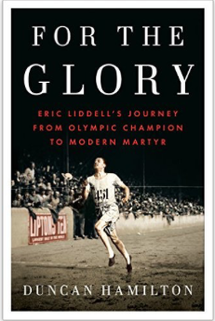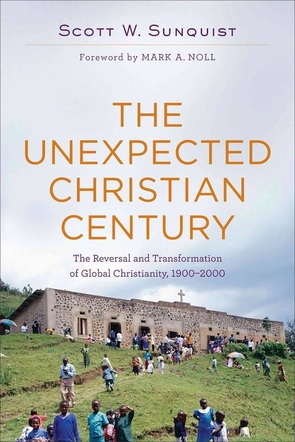posts
 On and off this summer, I have been reading through Duncan Hamilton's biography of Eric Liddell, entitled For the Glory. Liddell, of course, won the gold medal in the 400 meters in the 1924 Paris Olympics and his story was featured in the film "Chariots of Fire." The focus of Hamilton's book is what happened after the Olympics; that Liddell returned to China where his parents had been serving with the London Missionary Society and after a number of years serving as a missionary among the Chinese, he died of a brain tumor in a Japanese controlled concentration camp in 1945. Though Liddell received a good theological education in Scotland before going to China, what struck me from his biography was how he grew as a theologian amid the hardships in China, especially as the Japanese began to control the country more and more. After Liddell's LMS mission station was closed by the Japanese in 1941, he was placed under house arrest and was forbidden from preaching, leading church services, and visiting Chinese believers. It is interesting how Liddell--someone who believed in laboring every minute of the day for God's glory--responded to these constraints. Hamilton writes: Liddell was always scribbling on pads and loose paper, where he put down thoughts and ideas or short quotations that inspired him. His advice to everyone was: "Take a pen and pencil and write down what comes to you." Liddell was widening his knowledge of theology and committing to memory those few books of the Bible he couldn't already quote (p. 247). So Liddell, who was already a divinity school graduate, a Bible teacher, preacher, and missionary, used this season of limited activity to reflect on Scripture in his context of hardship and to grow as a theologian. In the twenty-first century western world, theology is often articulated from the comfort of offices, libraries, and in the stimulating environments of professional societies. Similar to the historical models of Cyprian of Carthage, Ephrem of Syria, and Athanasius of Alexandria, Liddell is an inspiring example of doing meaningful theology in the context of mission and suffering. Finally, what is also remarkable was the pace in which Liddell studied Scripture. He wrote, "Don't read hurriedly . . . every word is precious. Pause, assimilate" (p. 247). With some time on his hands, his approach to the Word was not rushed and he pursued his own sort of lectio divina (divine reading) made famous by the monk Benedict of Nursia and his followers. In short: slow theology in the crucible of hardship and suffering. I've just had the chance today to open Michael Bird's new book What Christians Ought to Believe: An Introduction to Christian Doctrine through the Apostle's Creed. I'm considering adopting it for a course in history of Christianity and also using it for a church small group this fall. As an evangelical Baptist influenced by Anglicanism and also the church fathers, I resonated with much of the rationale for the book and some of the claims in the first chapter: that Scripture contains many creedal statements (e.g. Deut 6:4-5; Phil 2:5-11) ; that the Apostle's Creed summarizes what Christians ought to believe while defending against unhealthy, heretical teaching (e.g. Docetism); and that all Christians, whether they realize it or not, read Scripture within some framework of tradition. To this last point, Bird wonderfully articulates the relationship of tradition and Scripture:
Inasmuch as we all have a "tradition," the creeds arguably provide the best tradition within which to read Scripture. This is because the creeds should be regarded as a biblically generated tradition that meets with the consensus of the universal church about what the main teachings of the Christian faith are. The creeds constitute an attempt to guide our reading of Scripture by setting out in advance the contents and concerns of Scripture itself. The creeds provide a kind of "Idiot's Guide to Christianity" by briefly laying out the story, unity, coherence, and major themes of the Christian faith. In that sense, a creedal faith is crucial for biblical faith and vice versa! In an age of confusion about spiritual truth--within society as well as within the church--an idiot's guide to the faith is a welcomed thing. Why not take a few minutes and reflect on the words and meaning of the Apostle's Creed? I BELIEVE in God, the Father almighty, creator of heaven and earth. I believe in Jesus Christ, his only Son, our Lord. He was conceived by the power of the Holy Spirit and born of the Virgin Mary. He suffered under Pontius Pilate, was crucified, died, and was buried. He descended to the dead. On the third day he rose again. He ascended into heaven, and is seated at the right hand of the Father. He will come again to judge the living and the dead. I believe in the Holy Spirit, the holy catholic Church, the communion of saints, the forgiveness of sins, the resurrection of the body, and the life everlasting. Amen.  Scott Sunquist is one of my favorite writers. I’ve greatly appreciated his previous works, Understanding Christian Mission and the two-volume History of the World Christian Movement. This latest work, The Unexpected Christian Century, effectively grew out of volume two of HWCM and in it he attempts to sketch out the history of global Christianity in the twentieth century. This is a tall order indeed and I appreciate his approach to the “global century” that began with some 80% of the world’s Christians living in North America or Europe and ended with about 60% living in the Global South—the non-western nations of Africa, Asia, and Latin America. In just six chapters—sandwiched between an introduction to world Christianity in the first nineteen centuries and a forward looking epilogue—Sunquist does a commendable job of narrating the story of twentieth-century Christian history. Here’s a brief chapter-by-chapter synopsis: In chapter 1 (“world Christianity”), the key trends in global Christianity at the beginning of the twentieth century area discussed. Chapter 2 (“Christian lives”) focuses on representative examples of global Christian innovators and leaders. In chapter 3 (“politics and persecution”), the global church is considered in the context of twentieth-century politics and discrimination against the church. The fourth chapter (“confessional families”) addresses the four key streams of global Christianity—Roman Catholics, Orthodox, Protestants, and Independent churches. Chapter 5 (“on the move”) captures the crucial issue of global migration and its relationship to Christianity. Finally, in chapter 6 (“one way among others”), the author discusses Christianity’s relationship with other religions in the twentieth-century context. As far as strengths go, I think Sunquist does capture the big picture of twentieth-century world Christianity through his framework in these chapters. In particular, I think the biographical approach of chapter 2 is excellent as he succeeds in putting a face on the global church. While famous Christians like Mother Theresa and Billy Graham are mentioned, it’s also good for the reader to meet lesser-known global Christian leaders and innovators as well. I also thought chapter 4 was an excellent survey of the main expressions of global Christianity, especially the “spiritual churches” (independent and Pentecostal), which comprise the fastest growing faith communities in the world. Indeed, the categories of Protestant, Catholic, and Orthodox no longer adequately tell the story of contemporary world Christianity. My only major critique of the book has to do with the group of world Christian leaders surveyed in chapter 2. The common element for most of them is that they are somehow connected to the World Council of Churches. While the independent churches are highlighted in chapter 4, their leaders do not figure as prominently in chapter 2. Also, I find it problematic that Ghandi was listed and surveyed in this chapter on Christian leaders. Though Ghandi had dealings with Christians in South Africa, Britain, and India and he influenced Christians like Martin Luther King, Jr, Ghandi himself was not a follower of Christ. To sum up, I am grateful for this well-written and engaging book on the global century and am happily adopting it (along with HWCM volume two) as a text for my course, History of Global Christianity II at CIU. |
Archives
November 2023
|
 RSS Feed
RSS Feed
